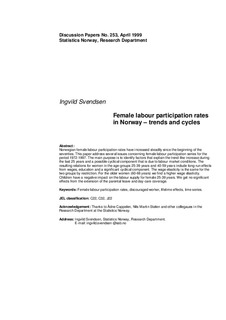| dc.contributor.author | Svendsen, Ingvild | |
| dc.date.accessioned | 2012-02-04T14:40:02Z | |
| dc.date.available | 2012-02-04T14:40:02Z | |
| dc.date.issued | 1999 | |
| dc.identifier.issn | 1892-753x | |
| dc.identifier.uri | http://hdl.handle.net/11250/180133 | |
| dc.description.abstract | Norwegian female labour participation rates have increased steadily since the beginning of the seventies. This paper address several issues concerning female labour participation series for the period 1972-1997. The main purpose is to identify factors that explain the trend-like increase during the last 25 years and a possible cyclical component that is due to labour market conditions. The resulting relations for women in the age-groups 25-39 years and 40-59 years include long-run effects from wages, education and a significant cyclical component. The wage elasticity is the same for the two groups by restriction. For the older women (60-66 years) we find a higher wage elasticity. Children have a negative impact on the labour supply for female 25-39 years. We get no significant effects from the extension of the parental leave and day-care coverage.
Keywords: Female labour participation rates, discouraged worker, lifetime effects, time series. | no_NO |
| dc.language.iso | eng | no_NO |
| dc.publisher | Statistics Norway, Research Department | no_NO |
| dc.relation.ispartofseries | Discussion Papers;No. 253 | |
| dc.subject | Labour participation | no_NO |
| dc.subject | Women | no_NO |
| dc.subject | Norway | no_NO |
| dc.subject | Discouraged worker | no_NO |
| dc.subject | Lifetime effects | no_NO |
| dc.subject | Time series | no_NO |
| dc.subject | Yrkesaktivitet | no_NO |
| dc.subject | Kvinner | no_NO |
| dc.subject | Norge | no_NO |
| dc.subject | JEL classification: C22 | no_NO |
| dc.subject | JEL classification: C32 | no_NO |
| dc.subject | JEL classification: J22 | no_NO |
| dc.title | Female labour participation rates in Norway - trends and cycles | no_NO |
| dc.type | Working paper | no_NO |
| dc.subject.nsi | VDP::Social science: 200::Economics: 210::Economics: 212 | no_NO |
| dc.source.pagenumber | 32 s. | no_NO |
